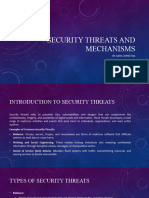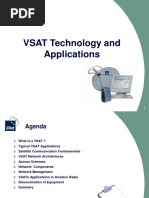0 ratings0% found this document useful (0 votes)
3 viewsNETWORK II L8
The document outlines the importance of network security, detailing various threats such as malware, phishing, and insider threats. It discusses surveillance techniques like network monitoring and intrusion detection systems, as well as security measures including firewalls, encryption, and access control. Additionally, it emphasizes the need for incident response plans and highlights emerging trends like AI and cloud security in enhancing network protection.
Uploaded by
monthec39Copyright
© © All Rights Reserved
Available Formats
Download as DOCX, PDF, TXT or read online on Scribd
0 ratings0% found this document useful (0 votes)
3 viewsNETWORK II L8
The document outlines the importance of network security, detailing various threats such as malware, phishing, and insider threats. It discusses surveillance techniques like network monitoring and intrusion detection systems, as well as security measures including firewalls, encryption, and access control. Additionally, it emphasizes the need for incident response plans and highlights emerging trends like AI and cloud security in enhancing network protection.
Uploaded by
monthec39Copyright
© © All Rights Reserved
Available Formats
Download as DOCX, PDF, TXT or read online on Scribd
You are on page 1/ 4
COMPUTER NETWORK II
Surveillance and Security of a Network
1. Introduction to Network Security
• Definition:
• Network security involves implementing measures to protect the integrity,
confidentiality, and availability of computer networks and data.
• Importance:
• Protects sensitive data from unauthorized access, e.g., preventing credit card fraud
in online transactions.
• Ensures reliable network performance, like maintaining uptime for e-commerce
websites.
2. Threats to Network Security
• Types of Threats:
• Malware (Malicious Software):
• Example: WannaCry Ransomware—encrypts files on infected systems
and demands payment for decryption.
• Phishing Attacks:
• Example: Emails that appear to be from a bank requesting account
verification, leading to stolen credentials.
• Denial of Service (DoS) Attacks:
• Example: Overloading a website with traffic, causing it to crash, as seen in
attacks on financial institutions.
• Man-in-the-Middle (MitM) Attacks:
• Example: Intercepting communications on unsecured Wi-Fi networks to
steal personal information.
• Insider Threats:
• Example: An employee leaking sensitive company data or credentials to
competitors.
3. Surveillance Techniques in Network Security
• Network Monitoring:
• Tools:
• Example: Wireshark—captures and analyzes network packets to identify
unusual traffic patterns.
• Purpose:
• Detects data exfiltration attempts, e.g., unauthorized uploading of sensitive
files.
• Intrusion Detection and Prevention Systems (IDPS):
• Types:
• Example: Snort (Network-Based IDPS)—monitors network traffic and
alerts on suspicious activity.
• Functionality:
• Detects port scanning activities or unauthorized access attempts.
• Logging and Analysis:
• Log Files:
• Example: Firewall logs that record all incoming and outgoing traffic to
identify anomalies.
• Event Correlation:
• Example: Using Splunk (a data analysis software) to aggregate logs from
various sources to identify coordinated attacks.
4. Security Measures and Best Practices
• Firewalls:
• Purpose:
• Example: A Cisco ASA (Adaptive Security Appliance) Firewall—filters
traffic based on predefined security rules.
• Types:
• Hardware firewalls used in corporate networks versus software firewalls
on individual devices (e.g., Windows Defender).
• Encryption:
• Importance:
• Example: HTTPS (Hypertext Transfer Protocol Secure)—encrypts data
sent between a web browser and server to secure online transactions.
• Protocols:
• Use of SSL (Secure Sockets Layer)/TLS (Transport Layer Security) to
secure data in transit, such as encrypting email communications.
• Access Control:
• Role-Based Access Control (RBAC):
• Example: Limiting access to sensitive financial data to only those in the
finance department.
• Multi-Factor Authentication (MFA):
• Example: Using an SMS code in addition to a password to access online
banking.
• Regular Security Audits:
• Purpose:
• Example: Conducting penetration testing to identify vulnerabilities in a
web application.
• Components:
• Review of security policies and practices against industry standards, like
ISO 27001 (an international standard for information security
management systems).
5. Incident Response and Recovery
• Incident Response Plan (IRP):
• Definition:
• A structured approach to manage security incidents.
• Key Steps:
• Preparation: Training staff on security protocols.
• Detection: Example: Using alerts from an IDPS to identify breaches.
• Containment: Isolating affected systems to prevent further damage, e.g.,
disconnecting a compromised server.
• Eradication: Removing malware from affected systems, such as using
antivirus tools.
• Recovery: Restoring systems from clean backups after a ransom ware
attack.
• Post-Incident Review: Analysing the incident to improve future response
strategies.
6. Emerging Trends in Network Security
• Artificial Intelligence (AI) and Machine Learning (ML):
• Usage:
• Example: Darktrace—uses AI to identify abnormal behavior in network
traffic.
• Zero Trust Architecture:
• Concept:
• Example: Implementing strict identity verification for every access
attempt, regardless of location.
• Cloud Security:
• Importance:
• Example: Utilizing tools like AWS Shield (Amazon Web Services Shield)
to protect cloud-hosted applications from DDoS (Distributed Denial of
Service) attacks.
Conclusion
Effective surveillance and security measures are essential for protecting networks from various
threats. Implementing robust monitoring tools, access controls, and incident response plans will
help safeguard organizational data and maintain network integrity.
You might also like
- Insulgard Status Register Map: Function Code Register Address Parameter Description Data Range Size100% (1)Insulgard Status Register Map: Function Code Register Address Parameter Description Data Range Size3 pages
- Network - Security Unit - 1,2 ReferenceNo ratings yetNetwork - Security Unit - 1,2 Reference19 pages
- Introduction To Network Security ProductsNo ratings yetIntroduction To Network Security Products9 pages
- Network Security Threats and Mitigation StrategiesNo ratings yetNetwork Security Threats and Mitigation Strategies36 pages
- CS Fundamentals - 4-Week Fourth - Technical - SessionNo ratings yetCS Fundamentals - 4-Week Fourth - Technical - Session24 pages
- NIS - Class - Test - II - QB ANSWERS PDFNo ratings yetNIS - Class - Test - II - QB ANSWERS PDF6 pages
- Chapter 1 - Introduction: - The Art of War, Sun TzuNo ratings yetChapter 1 - Introduction: - The Art of War, Sun Tzu36 pages
- 1.3 Cybersecurity Techniques and MechanismsNo ratings yet1.3 Cybersecurity Techniques and Mechanisms29 pages
- Information Security: Barbarians at The Gateway (And Just About Everywhere Else)No ratings yetInformation Security: Barbarians at The Gateway (And Just About Everywhere Else)32 pages
- Unit 5. Recent Trends in Computer and ApplicationsNo ratings yetUnit 5. Recent Trends in Computer and Applications11 pages
- Mastering Cyber Security A Comprehensive Guide: cyber security, #2From EverandMastering Cyber Security A Comprehensive Guide: cyber security, #2No ratings yet
- Uv 5r Uv 5ra Uv 5re Uv 5r Plus User FaqsNo ratings yetUv 5r Uv 5ra Uv 5re Uv 5r Plus User Faqs18 pages
- 5G Implementation Guideline v2.0 July 2019100% (2)5G Implementation Guideline v2.0 July 201930 pages
- Datasheet San Brocade Inter Switch Link TrunkingNo ratings yetDatasheet San Brocade Inter Switch Link Trunking2 pages
- Fundamentals of Microwave Communication PDFNo ratings yetFundamentals of Microwave Communication PDF51 pages
- Microwave Communication Link Basic Design ConsiderationsNo ratings yetMicrowave Communication Link Basic Design Considerations27 pages
- IT Application Tools in Business FQ1-FQ2No ratings yetIT Application Tools in Business FQ1-FQ226 pages
- Journal of Data Communication and NetworkingNo ratings yetJournal of Data Communication and Networking29 pages
- Designation Telephone No. Residence Office: Part - ViNo ratings yetDesignation Telephone No. Residence Office: Part - Vi18 pages
- Original Station Notice With GMA-7 2007 Kapuso JingleNo ratings yetOriginal Station Notice With GMA-7 2007 Kapuso Jingle3 pages
- Full download Industrial Automation and Control Systems Security Principles Second Edition Ronald L. Krutz pdf docx100% (2)Full download Industrial Automation and Control Systems Security Principles Second Edition Ronald L. Krutz pdf docx55 pages
- CS 241 Internet Services © Armando Fox Fox@cs - Stanford.eduNo ratings yetCS 241 Internet Services © Armando Fox Fox@cs - Stanford.edu27 pages
- 3GPP LTE (Long Term Evolution) : University of Kansas - School of EngineeringNo ratings yet3GPP LTE (Long Term Evolution) : University of Kansas - School of Engineering39 pages
- MOBICON Mobile Controller For GSM/GPRS Telemetry: 6ai 16-28di /12doNo ratings yetMOBICON Mobile Controller For GSM/GPRS Telemetry: 6ai 16-28di /12do2 pages
- Insulgard Status Register Map: Function Code Register Address Parameter Description Data Range SizeInsulgard Status Register Map: Function Code Register Address Parameter Description Data Range Size
- Network Security Threats and Mitigation StrategiesNetwork Security Threats and Mitigation Strategies
- CS Fundamentals - 4-Week Fourth - Technical - SessionCS Fundamentals - 4-Week Fourth - Technical - Session
- Chapter 1 - Introduction: - The Art of War, Sun TzuChapter 1 - Introduction: - The Art of War, Sun Tzu
- Information Security: Barbarians at The Gateway (And Just About Everywhere Else)Information Security: Barbarians at The Gateway (And Just About Everywhere Else)
- Unit 5. Recent Trends in Computer and ApplicationsUnit 5. Recent Trends in Computer and Applications
- Mastering Cyber Security A Comprehensive Guide: cyber security, #2From EverandMastering Cyber Security A Comprehensive Guide: cyber security, #2
- Microwave Communication Link Basic Design ConsiderationsMicrowave Communication Link Basic Design Considerations
- Designation Telephone No. Residence Office: Part - ViDesignation Telephone No. Residence Office: Part - Vi
- Original Station Notice With GMA-7 2007 Kapuso JingleOriginal Station Notice With GMA-7 2007 Kapuso Jingle
- Full download Industrial Automation and Control Systems Security Principles Second Edition Ronald L. Krutz pdf docxFull download Industrial Automation and Control Systems Security Principles Second Edition Ronald L. Krutz pdf docx
- CS 241 Internet Services © Armando Fox Fox@cs - Stanford.eduCS 241 Internet Services © Armando Fox Fox@cs - Stanford.edu
- 3GPP LTE (Long Term Evolution) : University of Kansas - School of Engineering3GPP LTE (Long Term Evolution) : University of Kansas - School of Engineering
- MOBICON Mobile Controller For GSM/GPRS Telemetry: 6ai 16-28di /12doMOBICON Mobile Controller For GSM/GPRS Telemetry: 6ai 16-28di /12do

























































































